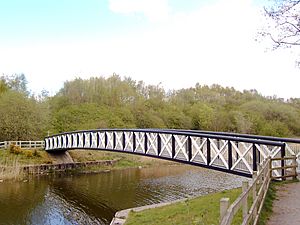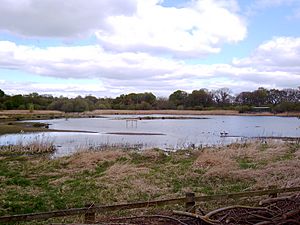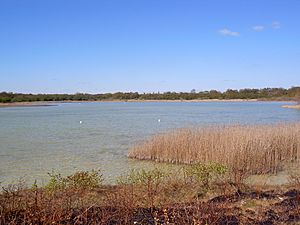Northwich Woodlands facts for kids
The Northwich Woodlands is a huge area of countryside near Northwich in Cheshire, England. It covers about 373 hectares, which is like 500 football fields! This special place is open to everyone. It includes nine different woods, parks, and lakes. Many of these areas are connected by paths, making it easy to explore.
A long time ago, much of this land was used for industry. People mined salt and made chemicals here. When salt was taken out of the ground, the land sometimes sank. This created big pools of water called "flashes." In the 1900s, the salt industry slowed down, and the land became unused. But now, most of the area has been cleaned up and made beautiful again. It's now a great place for nature and fun activities, and it's part of the Mersey Forest project.
Contents
Discovering Northwich Woodlands: Parks and Nature Areas
Northwich Woodlands is made up of nine unique spots. These include Marbury Country Park, Anderton Nature Park, Dairy House Meadows, Forge Woods, Hopyards Woods, Marshall's Woods, Ashton's Flash, Furey Woods, and Carey Park. Each one offers something different to explore!
Marbury Country Park: A Historic Green Space
In the northern part of the Woodlands, next to Budworth Mere, you'll find Marbury Country Park. This used to be a large private estate owned by a family called Smith-Barry. The old house, Marbury Hall, was taken down in 1968. But in 1975, the park was brought back to life! Now, Cheshire West and Chester Council manages it as a public country park.
You can still see parts of its past, like an arboretum (a collection of different trees), an ice-house (used to store ice long ago), and rows of lime trees. There's also an area of very old trees called Big Wood. This wood is important for wildlife, especially for birds like the lesser spotted woodpecker.
Anderton Nature Park: Riverside Wildlife Haven
Anderton Nature Park stretches along the northern side of the River Weaver and Witton Brook. It goes from the famous Anderton Boat Lift in the west to Haydn's Pool in the east. Haydn's Pool used to be called Marbury No. 1 Sludge Bed.
You can walk along many paths through grassy areas and newly planted woods. Keep an eye out for interesting plants, like the rare pennyroyal flower. Haydn's Pool is a great spot for waterbirds, and you might even see a green sandpiper there often.
Neumann's and Ashton's Flashes: Unique Water Habitats
These "flashes" are large pools of water located in the south-east of the Woodlands. From the 1940s, a company called ICI used them to store lime waste. But by the 1970s, they were no longer used.
Today, paths and bird hides (small buildings to watch birds without disturbing them) have been built around the flashes. Many special plants that like alkaline (chalky) soils grow here. These include the fragrant orchid, marsh helleborine, and yellow-wort. This area is also a very important home for the dingy skipper butterfly. You can see many different ducks, waders (birds that walk in shallow water), and other waterbirds here. Sometimes, rare birds like the broad-billed sandpiper or Caspian tern visit too!
Witton Lime Beds: A Special Scientific Site
Right next to Neumann's and Ashton's Flashes, within a bend of Witton Brook, is Witton Lime Beds. This area is so important for nature that it's called a Site of Special Scientific Interest (SSSI). This means it's protected because it has rare plants, animals, or geological features.
Carey Park: From Landfill to Green Space
Carey Park is the park closest to the town of Northwich. It opened in 2003 and was named after Councillor Ron Carey. He played a big part in turning this area into a park. It used to be a landfill site, where rubbish was buried. The project to change it into a park took seven years!
Carey Park is also a Site of Special Scientific Interest (SSSI). It's home to rare grasses and butterflies, along with other wildlife. If you like running, the Northwich Parkrun event takes place in this park.





